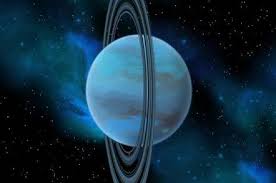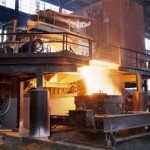Uranus- Planet With a Strange Way of Rotation
Uranus is an icy planet and appears in an azure blue colour. It is different from terrestrial planets and gaseous planets and is located in a huge, cold world far out in space. Uranus is surrounded by many black rings and icy moons. The seventh planet in the solar system is at a distance of 2.9 billion kilometers from the sun and is about four times wider than Earth. Most of the mass of Uranus is a hot, dense fluid of icy materials and water, methane and ammonia above a small rocky core. Its atmosphere is made of molecular hydrogen, atomic helium and a small quantity of methane. The planet was the first one found with the aid of a telescope. It was initially thought of a comet or star. It was recognised as a planet after two years of its discovery.
Rings of Uranus
The rings around planets Jupiter and Saturn make them distinct and look special. The rings of Uranus are composed of extremely dark particles in size varying from micrometers to a fraction of a metre. Thirteen rings have been identified so far and none of them is visible to naked eyes. Roman letter epsilon is used to indicate the brightest among them. All except two rings are extremely narrow, not more than a few kilometers wide. These rings are probably quite young. Existence of rings around Uranus was suspected from 18th century onwards, but was identified only on March 10, 1977. It was an accidental discovery and scientists James L Elliot, Edward W Dunham and Jessica Mink identified the presence of ring while observing the passage of a star behind the disc of the planet Uranus.
Uranus and its moons
Uranus is expected to have many moons. Only twenty seven natural satellites have been identified so far. They are named after fictional characters from the works of William Shakespeare and Alexander Pope. Some of them are Miranda, Umbriel, Ariel, Titania and Oberon. Ariel is the brightest of Uranus moons.
Uranus, planet with a unique style of rotation
The planet Uranus has a strange way of rotation. The tilts in the axis causes seasons in planets. Uranus has an unusual tilt of 98 degree and scientists believe it was caused by the hit of a huge object. The planet spins almost horizontally in space. It takes 84 years to orbit the sun. Each pole of Uranus has 42 years of sunlight followed by 42 years of darkness. Despite this, there are only few degrees of differences in temperature between the dark and light sides as the planet is so far from the sun. The average temperature is minus 224.2 degrees Celsius.
Exploration of Uranus
The story of exploration of Uranus started in 1986. Voyager 2 by NASA, which was an interplanetary probe, encountered Uranus in 1986. It was launched in 1977. Voyager 2 made its closest approach to Uranus on January 24, 1986 by coming within 81,500 km before continuing its journey to Neptune. The spacecraft studied the structure and chemical composition of the atmosphere and weather. It also studied its moons, discovered ten new moons and two more rings.









